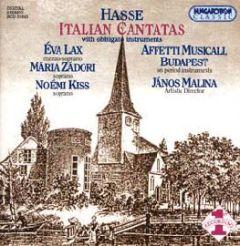Hasse - Italian Cantatas With Obbligato Instruments (2000)
Hasse - Italian Cantatas With Obbligato Instruments (2000)

Se il cantor trace (15´44˝) 1 Recitativo. Se il cantor trace (1´40˝) 2 Aria. Sí che sei ben fortunato (6´23˝) 3 Recitativo. Deh, rammentati almeno (1´12˝) 4 Aria. Se sapessi con la morte (6´30˝) Per palesarti appieno (12´27˝) 5 Recitativo. Per palesarti appieno (0´47˝) 6 Aria. Chi al suo fedel non rende (4´47˝) 7 Recitativo. E tu crudel mi temi (1´02˝) 8 Aria. Allorché s'amano (5´51˝) Euridice e Orfeo - cantata a due (15´22˝) 9 Recitativo. Dalle tenebre orrende (1´51˝) 10 Duetto. Mia vita / Cor mio (5´40˝) 11 Recitativo. Vieni dell'alma mia (2´43˝) 12 Duetto. Fatal forza (5´08˝) Clori, Clori, mia vita (16´24˝) 13 Recitativo. Clori, Clori, mia vita (0´59˝) 14 Aria. Se tu guardi (8´54˝) 15 Recitativo. Deh vieni, sí (0´46˝) 16 Aria. Vanne e trova nella morte (5´45˝) Bell'Aurora (13´50˝) 17 Aria. Bell'Aurora (5´35˝) 18 Recitativo. Esci dal chiuso albergo (2´13˝) 19 Aria. L'amorosa tortorella (6´02˝) Eva Lax - mezzo-soprano 1-8, 13-16 Maria Zadori - soprano 9-12, 17-19 Noemi Kiss - s soprano 9-12 AFFETTI MUSICALI BUDAPEST on period instruments: János Bali, János Malina - recorder 6, 8 István Kertész - violin 1-4, 14, 16-19 Erika Petőfi - violin 1-4, 14, 16 Csilla Vályi - violoncello 1-19 János Mezei - harpsichord 1-19 Janos Malina - artistic director
Johann Adolf Hasse never will make the top 10 list of Baroque composers, but anyone who enjoys Bach, Handel, and Vivaldi and who remains unfamiliar with this highly skilled melodist whose works show a keenly disciplined sense of structure and formal balance, would do well to take a close listen. In these so-called "Italian cantatas", Hasse, who like Handel was from northern Germany but spent time studying and composing in Italy, reveals the traits that made him a popular and envied opera composer. Even Mozart and Haydn spoke highly of his accomplishments, which also included oratorios, liturgical music for churches in Dresden and Venice, and a number of instrumental works. However, it's his vocal pieces, exemplified in the secular cantatas performed here, that really call our attention to music that deserves wider acceptance. Although Hasse's cantatas inevitably are compared to Alessandro Scarlatti's own (Scarlatti was one of Hasse's teachers and was more or less the "father" of the Italian cantata), a work such as Hasse's Euridice e Orfeo, for two sopranos and obbligato instruments, shows a masterful--and economical--treatment of the drama with some intricately interwoven and thoroughly engaging solo lines.
The singers--especially sopranos Mária Zádori and Noémi Kiss--display lovely, clear, warm-focused voices and are fully in command of the music and the style. They really seem to enjoy their duet--a sentiment shared by their instrumental partners. And speaking of instruments: the Affetti Musicali Budapest is a first rate ensemble that gets the benefit of Hungaroton's excellently balanced, vivid sonics. Éva Lax, who performs three of the solo cantatas, actually sounds more like a countertenor than a mezzo, and she has a facile technique that allows her to just spin out her lines as if born to this music. These five works, four of which strictly follow the accepted four-part form of recitative-aria-recitative-aria, are certainly not masterpieces, but they are worthy representatives of the output of another highly regarded 18th-century composer unfairly hidden in the long shadows of Georg Frederic and Johann Sebastian. ---David Vernier, ClassicsToday.com
download (mp3 @320 kbs):
yandex mediafire ulozto gett bayfiles
Zmieniony (Sobota, 02 Marzec 2019 18:22)








